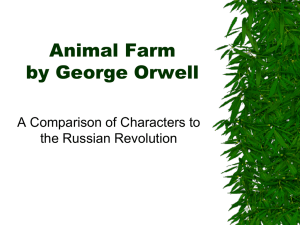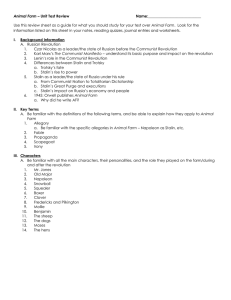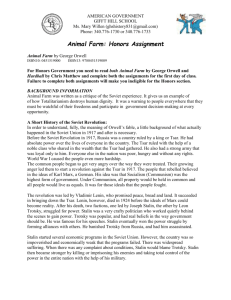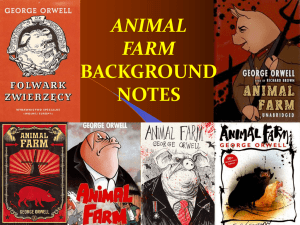Animal Farm Day 1
advertisement
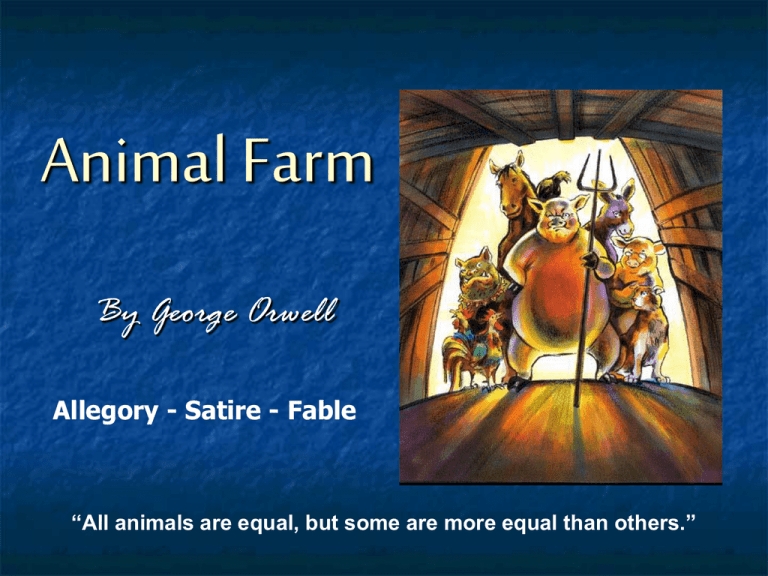
Animal Farm By George Orwell Allegory - Satire - Fable “All animals are equal, but some are more equal than others.” Today’s goal To recognize the elements of Animal Farm that contribute to its satire of Soviet Russia Reminder: Test on Wednesday Introduction to the novel Plot summary activity Background to Soviet Russia Synthesis Intro to Padlet homework assignment George Orwell British Author & Journalist 1903-1950 Born in India At that time India was a part of the British Empire, and Blair's father, Richard, held a post as an agent in the Opium Department of the Indian Civil Service. The Blair family was not very wealthy - Orwell later described them ironically as "lower-uppermiddle class". They owned no property, had no extensive investments; they were like many middle-class English families of the time, totally dependent on the British Empire for their livelihood and prospects. Noted as a novelist and critic, as well as a political and cultural commentator One of the most widely admired Englishlanguage essayists of the 20th century Best known for two novels critical of totalitarianism in general, and Stalinism in particular: Animal Farm Nineteen Eighty-Four “Liberty is telling people what they do not want to hear.” Why animals? In explaining how he came to write Animal Farm, Orwell says he once saw a little boy whipping a horse and later he wrote, “It struck me that if only such animals became aware of their strength we should have no power over them, and that men exploit animals in much the same way as the rich exploit the [worker].” What is Animal Farm? A masterpiece of political satire, Animal Farm is a tale of oppressed individuals who long for freedom but ultimately are corrupted by assuming the very power that had originally oppressed them. The story traces the deplorable conditions of mistreated animals who can speak and who exhibit many human characteristics. After extreme negligence by their owner, the animals revolt and expel Mr. Jones and his wife from the farm. The tale of the society the animals form into a totalitarian regime is generally viewed as Orwell's critique of the communist system in the former Soviet Union. Interesting Fact: Orwell initially struggled to find a publisher for Animal Farm. Significance Today But why – now that Soviet Communism has fallen and the Cold War is over – does Animal Farm deserve our attention? The answer lies in the power of allegory. Allegorical fables, because they require us to make comparisons and connections, can be meaningful to any reader in any historical period. The story of Animal Farm will always have lessons to teach us about the ways that people abuse power and manipulate others. Orwell's chilling story of the betrayal of idealism through tyranny and corruption is as fresh and relevant today as when it was first published in 1945. Plot Summary Activity When History and Literature Merge Critics often consider Animal Farm to be an allegory of the Russian Revolution. In the early 1900s, Russia’s Czar Nicholas II faced an increasingly discontented populace. Freed from feudal serfdom in 1861, many Russian peasants were struggling to survive under an oppressive government. By 1917, amidst the tremendous suffering of World War I, a revolution began. In two major battles, the Czar’s government was overthrown and replaced by the Bolshevik leadership of Vladimir Lenin. When Lenin died in 1924, his former colleagues Leon Trotsky, hero of the early Revolution, and Joseph Stalin, head of the Communist Party, struggled for power. Stalin won the battle, and he deported Trotsky into permanent exile. Czar Nicholas II Vladimir Lenin Joseph Stalin Leon Trotsky Joseph Stalin Once in power, Stalin began, with despotic urgency and exalted nationalism, to move the Soviet Union into the modern industrial age. His government seized land in order to create collective farms. Stalin’s Five Year Plan was an attempt to modernize Soviet industry. Many peasants refused to give up their land, so to counter resistance Stalin used vicious military tactics. Rigged trials led to executions of an estimated 20 million government officials and ordinary citizens. The government controlled the flow and content of information to the people, and all but outlawed churches. Joseph Stalin Synthesis You will be able to… Recognize the elements of Animal Farm that contribute to its satire of Soviet Russia You will circulate through six stations that highlight these elements Napoleon = Joseph Stalin Napoleon Boar who leads the rebellion against Farmer Jones After the rebellion’s success, he systematically begins to control all aspects of the farm until he is an undisputed tyrant. Joseph Stain The communist dictator of the Soviet Union from 1922-1953 who killed all who opposed him. He loved power and used the KGB (secret police) to enforce his ruthless, corrupt antics. Farmer Jones = Czar Nicholas II Farmer Jones The irresponsible owner of the farm Lets his animals starve and beats them with a whip Sometimes shows random kindness Czar Nicholas II Weak Russian leader during the early 1900s Often cruel and brutal to his subjects Displays isolated kindess Snowball = Leon Trotsky Snowball Boar who becomes one of the rebellion’s most valuable leaders. After drawing complicated plans for the construction of a windmill, he is chased off of the farm forever by Napoleon’s dogs and thereafter used as a scapegoat for the animals’ troubles. Leon Trotsky A pure communist leader who was influenced by the teachings of Karl Marx. He wanted to improve life for people in Russia, but was driven away by Lenin’s KGB. Characters Old Major An old boar whose speech about the evils perpetrated by humans rouses the animals into rebelling. His philosophy concerning the tyranny of Man is named Animalism. He teaches the animals the song “Beasts of England” Dies before revolution Karl Marx The inventor of communism Wants to unite the working class to overthrow the government. Dies before the Russian Revolution Who is Karl Marx? Many of the ideals behind the Soviet revolution were based on the writings and teachings of Karl Marx. A German intellectual who lived in the mid-1800s, Marx believed that societies are divided into two segments, a working class and an owner class. The working class creates all the products, while the owner class enjoys all the benefits of these products. This class division leads to inequality and oppression of the working class. Marx’s objective was to create a classless society in which the work is shared by all for the benefit of all, and he believed revolution was the way to achieve this goal. Squealer & Boxer Squealer A big mouth pig who becomes Napoleon’s mouthpiece. Throughout the novel, he displays his ability to manipulate the animals’ thoughts through the use of hollow, yet convincing rhetoric. Represents the propaganda department that worked to support Stalin’s image; the members of the department would use lies to convince the people to follow Stalin. Boxer A dedicated but dimwitted horse who aids in the building of the windmill but is sold to a glue-boiler after collapsing from exhaustion. Represents the dedicated, but tricked communist supporters of Stalin. Many stayed loyal even after it was obvious Stalin was a tyrant. Eventually they were betrayed, ignored, and even killed by him. Squealer Boxer Jessie & Moses Jessie The farm's sheepdog, she keeps tabs on the pigs and is among the first to suspect that something is wrong at Animal Farm. Moses A tame raven and sometimes-pet of Jones who tells the animals stories about a paradise called Sugarcandy Mountain. Moses represents religion. Stalin used religious principles to influence people to work and to avoid revolt. Jessie Moses More Characters Pilkington Jones' neighbor, he finds a way to profit from Animal Farm by forming an alliance with the pigs. Muriel A goat who believes in the rebellion, she watches as Animal Farm slips away from its founding principles. Mollie A vain horse who resists the animal rebellion because she doesn't want to give up the petting and treats she receives from humans. Mollie represents vain, selfish people in Russia and throughout the world who ignored the revolution and sought residence in more inviting countries. Benjamin The most cynical of all the animals, the farm's donkey doubts the leadership of the pigs but is faithfully devoted to Boxer. Benjamin represents all the skeptical people in Russia and elsewhere who weren’t sure revolution would change anything. The Sheep Not tremendously clever, the sheep remind themselves of the principles of animalism by chanting "four legs good, two legs bad." The Dogs Napoleon’s private army that used fear to force the animals to work; they killed any opponent of Napoleon. The dogs represent Stalin’s loyal KGB (secret police). The KGB were not really police, but mercenaries used to force support for Stalin. Animalism = Communism Animalism Taught my Old Major No rich, but no poor Better life for workers All animals are equal Everyone owns the farm Communism Invented by Karl Marx All people are equal Government owns everything People own the government Animal Farm Revolution = Russian Revolution Animal Farm Revolution Was supposed to make life better for all, but . . . Life was worse at the end. The leaders became the same as, or worse than the other farmers (humans) they rebelled against. Russian Revolution Was supposed to fix the problems created by the Czar, but . . . Life was even worse after the revolution. Stalin made the Czar look like a nice guy. Padlet task You will find the Padlet task here The link is also on the class website Padlet task
